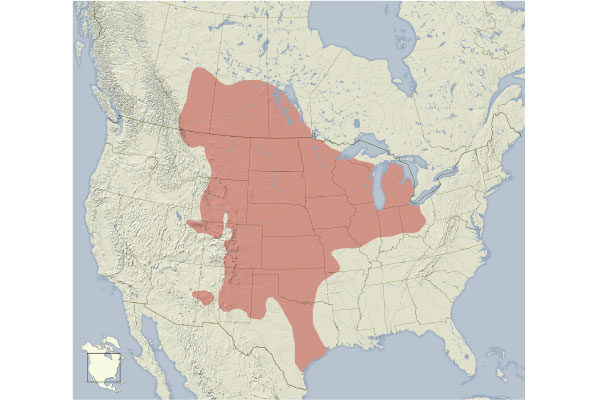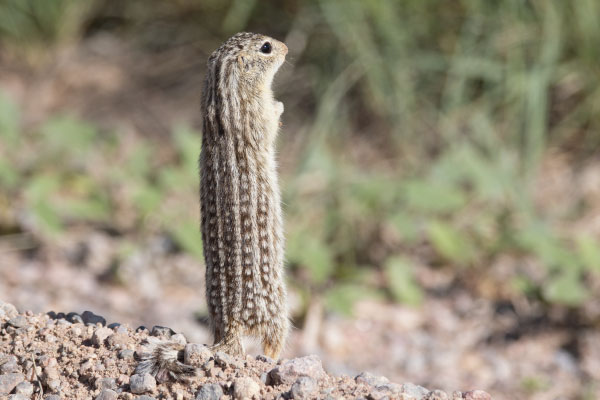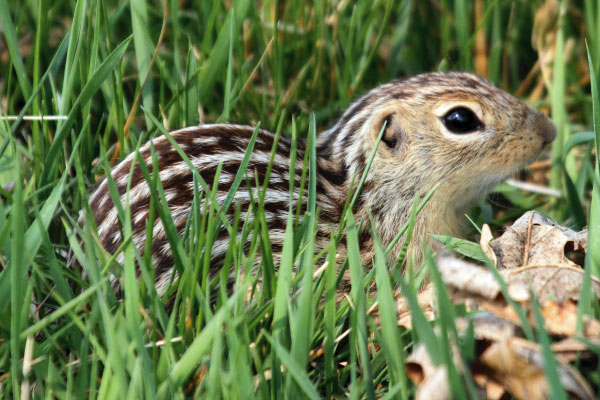We are talking about the striking Thirteen-lined Ground Squirrel, a rather small ground squirrel that is only slightly larger than the Least Chipmunk, the smallest species of chipmunk. Also known colloquially as the Striped Gopher, Leopard Ground Squirrel or even Thirteen-Liner, the Thirteen-lined Ground Squirrel squirrel is extensively distributed over the grasslands and prairies of central North America, the Boreal Forest forming the northern limit of its range.

Distribution map of the thirteen-lined ground Squirrel (Photo credit: NordNordWest)
The Thirteen-lined Ground Squirrel is so named for its alternating stripes of dark brown and tan that extend from the nape to the base of the tail. The brown stripes are broader than the tan lines and display orderly little tan spots in on the midline. It is believed that this pattern helps the thirteen-lined ground squirrel blend into the landscape and provides protection from predators. The other ground squirrels found in Saskatchewan – Franklin's Ground Squirrel and Richardson’s Ground Squirrel – are considerably larger and have plain coats.

Thirteen-lined Ground Squirrel (Photo by: Bettina Arrigoni)
Thirteen-lined Ground Squirrels prefer open areas with short grass, and can be found in lawns, golf courses and well-grazed pastures, and roadsides in addition to wild prairie habitat. These beautiful little rodents are omnivorous. While seeds and leaves constitute the bulk of their diet, they will also readily devour caterpillars, grasshoppers, and beetles and bird eggs – in fact, they are one of the most common predators of grassland songbird nests. In addition, they will also consume carrion, including the dead of their own species!
Exclusively diurnal, Thirteen-lined Ground Squirrels sport short ears and a thin tail, and will often sit erect with head pointed up, and this stance may even remind you of a Meerkat (to which it is not related)! An interesting behaviour that this squirrel shares with other squirrel species is its propensity to hoard seeds, which it carries in little pouches in its cheeks and stores them underground for later consumption.

(Photo by: Greg Schechter)
Thirteen-lined Ground Squirrels, like several other ground squirrels, hibernate during the winter. They enter their burrows in October and emerge in late March or early April, when the soil warms up enough for them to dig out. Their hibernation chambers lays below the frost line and so the air temperature never drops to below zero. During hibernation, the squirrels’ heart rate, body temperature and metabolism drops dramatically, and they go into a state of torpor, much like groundhogs. Males are ready to reproduce as soon as they emerge, and females become receptive 4-5 days later.
You may have the opportunity to observe this gorgeous squirrel species on our ‘In Search of Whoopers’ this fall, when we go on a quest in Saskatchewan in search of the majestic Whooping Crane, the rarest breeding bird in North America. Led by naturalist extraordinaire Gabriel Foley, we will also observe one of the world’s best birding spectaculars: the fall waterfowl and shorebird migration on the Canadian Prairies!
___________________________________________________________________________
Join us on tour!
In Search of Whoopers
Led by: Gabriel Foley
October 2 - 6, 2024 | Click here to learn more


